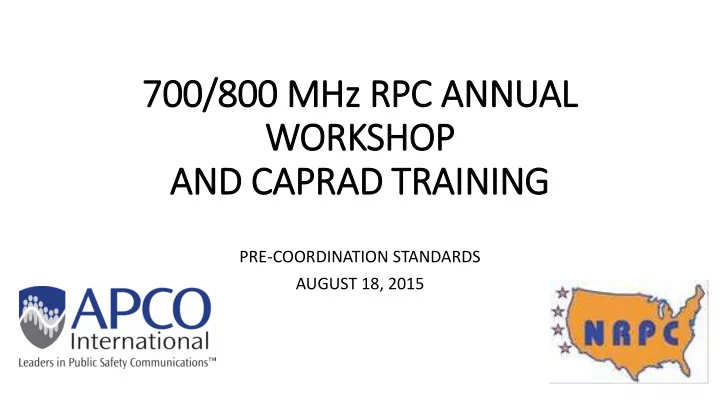

700/800 MHz Hz RPC RPC AN ANNUAL L WORK ORKSHOP AND CAPRA RAD TRA RAINING PRE-COORDINATION STANDARDS AUGUST 18, 2015
OBJECTIVE To develop a standard for spectrum coordination for all RPC regions for 700 MHz and 800 MHz that • reflects current best practices • uses standard based propagation models • is technology neutral • can be implemented by all regions for use in updated plans 2
Online Survey • Sent out in mid 2013 • Varied responses • Regional differences noted • Many inconsistencies • NO STANDARD APPROACH 3
RPC Regions Responding to Survey 4
700 MHZ Regional differences significant • Propagation models varied from R6602, Okumura, Longley Rice, to Hybrids • No standard levels for Co to Co channel or Adjacent channels • Impact to adjacent regional review in many areas • Prediction tool variances • Most regions not having a defined calibration site or model 5
Proposed 700 MHz Coordination Parameters Propagation Model • Longley Rice 50/50/50 • Rx antenna height: 1.5 meters AGL • Calculation distance: 150km minimum • Clutter Attenuation: Use TSB88C or latest • Ground Type: Average • Radio Climate: Use appropriate selection or Continental Temperate as a default • Antenna pattern used shall be the proposed antenna plus any mechanical tilts 6
Proposed 700 MHz Coordination Parameters Coverage Prediction • Service Coverage Level: 40 dBu / -94 dBm Demonstration of Responsible RF • 80 % of the 52dBu / -82 dBm is within the defined service area + 8km buffer 7
Proposed 700 MHz Coordination Parameters Interference Levels: Baseline co-channel level: 15 dBu / -119 dBm • Base line level shall be de-rated to account for adjacent coupled power ratio effects consistent with the National Coordinating Committee recommendations of July 2002 • 40 dB ACCPR: 55 dBu / -79dBm • 65 dB ACCPR: 80 dBu / -54 dBm 8
National Coordination Committee, “Pre –Assignment Rules and Recommendations,” July 2002 Adjacent Channel Coupled Power Ratio Values. 9
Proposed 700 MHz Coordination Parameters Calibration Site • Each region to develop a “Calibration site” or multiple “Calibration Sites” depending on varying terrain • Calibration site parameters to be identified along with coverage prediction showing distances • Region to provide all parameters, omni antenna, heights, erp etc…. • Prediction levels: (service level/interference levels) • Applicants as part of their submission must complete a calibration propagation showing general agreement to the Region’s plot in the plan 10
SAMPLE CALIBRATION PLOT with Present RPC8 values 11
800 MHZ NPSPAC Regional parameters generally consistent • Propagation model mostly Okumura-HATA-Davidson • Standard levels generally for Co to Co channel or Adjacent channels • Prediction tool variances present among RF software tools • Most regions not having a defined calibration site • Differences in modulation/RF bandwidths generally NOT taken into effect 12
Proposed 800 MHz NPSPAC Coordination Parameters Foundations that are to be stressed **Systems licensable using 6.25Khz, 12.5 Khz, and 25 Khz channel widths **Maximum emission bandwidth shall be that equivalent to 4 Khz deviation, e.g. 16K0 13
Proposed 800 MHz NPSPAC Coordination Parameters Primary Propagation Model Alternate Propagation Model • OKUMURA-HATA-DAVIDSON • Longley Rice 50/50/50 • Rx antenna height : 1.5 meters AGL • Rx antenna height :1.5 meters AGL • Calculation distance: 150km minimum • Calculation distance: 150km minimum • Environment: Open • Clutter Attenuation: Use TSB88C or latest • Antenna pattern used shall be the proposed antenna plus any • Ground Type: Average mechanical tilts. • Radio Climate: use appropriate selection or Continental Temperate as a default • Antenna pattern used shall be the proposed antenna plus any mechanical tilts. 14
Proposed 800 MHz NPSPAC Coordination Parameters Calibration Site • Each region to develop a “Calibration site” or multiple “Calibration Sites” depending on varying terrain • Calibration site parameters to be identified in plan and in CAPRAD along with coverage prediction showing distances • Region to provide all parameters, omni antenna, heights, erp etc…. • Prediction levels: (service level/interference levels) • Applicants as part of their submission must complete a calibration propagation showing general agreement to the Region’s plot in the plan 15
Proposed 800 MHz NPSPAC Coordination Parameters Coverage Prediction • Service Coverage Level: 40 dBu / -94 dBm Demonstration of Responsible RF • 80 % of the 52dBu / -82 dBm is within the defined service area + 8km buffer 16
Proposed 800 MHz NPSPAC Coordination Parameters Interference Levels Baseline co-channel level: 15 dBu / -119 dBm Adjacent Channel Cases: 1. 12.5 Khz proposed against adjacent 12.5 Khz adjacent users • 40dBu /-94dBm shall not overlap adjacent incumbents’ 40 dBu/-94 dBm 2. 25 Khz proposed against adjacent users regardless of adjacent user channel widths • 25 dBu / -109 dBm shall not overlap adjacent incumbents’ 40 dBu/-94 dBm 17
Next Steps? 18
Recommend
More recommend